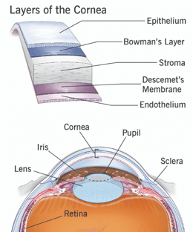Corneal Care

What is the cornea?
The cornea is the transparent outer layer positioned directly in front of the iris and pupil so as to allow light to enter the eye. It consists of five layers: the epithelium, Bowman’s layer, the stroma, Descemet’s membrane, and the endothelium. Each layer is described below.
Epithelium: The epithelium is the protective outer layer that serves as the first line of defense against dust, debris, and bacteria.
Bowman’s Layer: Bowman’s layer is a smooth layer, located between the epithelium and the stroma.
Stroma: The stroma is the central layer of the cornea, making up 90% of its entirety. It is comprised of collagen and other materials.
Descemet’s Membrane: The layer of collagen fibers positioned between the stroma and the endothelium is called Descemet’s membrane.
Endothelium: On Descemet’s membrane is a single layer of squamous cells called the endothelium. It is the innermost layer of the cornea, forming a border between circulating blood and fluids.
Maintaining your corneal health is vital in order to sustain your vision. Simple to complex infections and diseases require seeing professional diagnosis and care. Left untreated, some corneal conditions can result in the clouding and distortion of vision as well as potential blindness. While infections related to contact lenses, abrasions from trauma, and inflammation are common, they do require treatment. Other cornea ailments including keratoconus, Fuchs’ endothelial dystrophy, and pterygia. Consult with our experienced team of ophthalmologists for the best care.
Symptoms of Corneal Infection or Disease

Corneal Abrasions – Feeling like something is stuck in your eye; red, painful, watery eyes; blurry or hazy vision; and being extra sensitive to light.
Corneal Ulcers – Red eyes; eye pain; the feeling of having something in your eye; tearing, pus or other discharge; blurred vision; sensitivity to light; swollen eyelids; and a white spot on your cornea.
Dry Eye Syndrome – Dry eye syndrome occurs when there are not enough tears produced to maintain the moisture layer on the outer portion of the cornea. This can be the result of a gland dysfunction or of the eyelid not closing completely. Left untreated, such dryness may cause eye damage.
Contact Lens Irritation or Infection – When contact lenses are not properly worn or cared for, the risk of corneal damage or infection increases.
Keratoconus – Keratoconus is a progressive condition that weakens the central part of the cornea. This can result in a cone-shaped deformity. Early diagnosis and treatment is vital for preventing the condition’s progression. Untreated keratoconus can result in blurry vision, double vision, nearsightedness, astigmatism, and light sensitivity.
Fuchs’ Endothelial Dystrophy – Fuchs’ Endothelial Dystrophy affects the endothelium layer of the cornea. Symptoms include glare, blurry vision, pain, or grittiness from tiny blisters on the surface of your cornea. If left untreated it can lead to Bullous Keratopathy, a secondary condition in which the cornea becomes permanently swollen.
Risk Factors Associated with Cornea Damage or Disease
- Infection
- Age
- Heredity
- Cataract and intraocular lens implant surgery
- Contact lenses
- Eye trauma
- Certain systemic diseases
Diagnosing Corneal Infections, Damage, or Disease
The only way to ensure proper diagnosis of cornea conditions is to schedule an appointment with your eye doctor. They will use a variety of specialized instruments to examine the health of your eye and its structure. The examination may include dilation. Eye exams are non-invasive and painless.
Treatment for Cornea Infections, Damage, or Disease
It is better to protect your vision by treating symptoms immediately, before they have a chance to adversely affect your vision. Treatments range from eye drops to more extensive procedures. Your doctor will provide the most effective options for your needs.
With more permanent damage, a corneal transplant may be required. With advances in medicine there are procedures such as Descemet Stripping Endothelial Keratoplasty (DSEK) and Descemet Membrane Endothelial Keratoplasty (DMEK) that may be implemented in certain cases to help restore vision.
We are here for you, to support your ocular health and cornea treatment needs.





